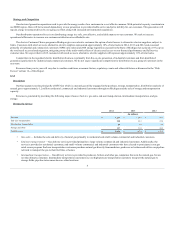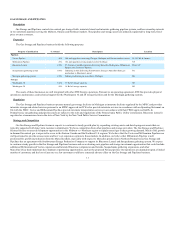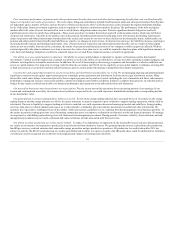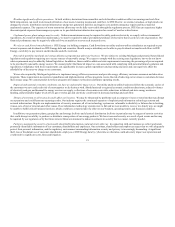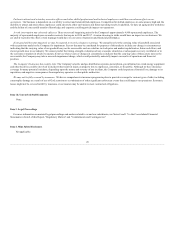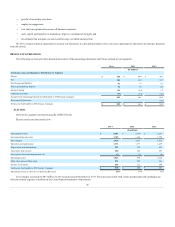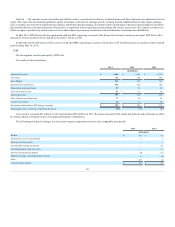DTE Energy 2014 Annual Report Download - page 20
Download and view the complete annual report
Please find page 20 of the 2014 DTE Energy annual report below. You can navigate through the pages in the report by either clicking on the pages listed below, or by using the keyword search tool below to find specific information within the annual report.
Poor investment performance of pension and other postretirement benefit plan assets and other factors impacting benefit plan costs could unfavorably
impact our liquidity and results of operations. Our costs of providing non-contributory defined benefit pension plans and other postretirement benefit plans
are dependent upon a number of factors, such as the rates of return on plan assets, the level of interest rates used to measure the required minimum funding
levels of the plans, future government regulation, and our required or voluntary contributions made to the plans. The performance of the debt and equity
markets affects the value of assets that are held in trust to satisfy future obligations under our plans. We have significant benefit obligations and hold
significant assets in trust to satisfy these obligations. These assets are subject to market fluctuations and will yield uncertain returns, which may fall below
our projected return rates. A decline in the market value of the pension and other postretirement benefit plan assets will increase the funding requirements
under our pension and other postretirement benefit plans if the actual asset returns do not recover these declines in the foreseeable future. Additionally, our
pension and other postretirement benefit plan liabilities are sensitive to changes in interest rates. As interest rates decrease, the liabilities increase, resulting in
increasing benefit expense and funding requirements. Also, if future increases in pension and other postretirement benefit costs as a result of reduced plan
assets are not recoverable from our utility customers, the results of operations and financial position of our company could be negatively affected. Without
sustained growth in the plan investments over time to increase the value of our plan assets, we could be required to fund our plans with significant amounts of
cash. Such cash funding obligations could have a material impact on our cash flows, financial position, or results of operations.
Our ability to access capital markets is important. Our ability to access capital markets is important to operate our businesses and to fund capital
investments. Turmoil in credit markets may constrain our ability, as well as the ability of our subsidiaries, to issue new debt, including commercial paper, and
refinance existing debt at reasonable interest rates. In addition, the level of borrowing by other energy companies and the market as a whole could limit our
access to capital markets. Our long term revolving credit facilities do not expire until 2018, but we regularly access capital markets to refinance existing debt
or fund new projects at our utilities and non-utility businesses, and we cannot predict the pricing or demand for those future transactions.
Construction and capital improvements to our power facilities and distribution systems subject us to risk. We are managing ongoing and planning future
significant construction and capital improvement projects at multiple power generation and distribution facilities and our gas distribution system. Many
factors that could cause delays or increased prices for these complex projects are beyond our control, including the cost of materials and labor, subcontractor
performance, timing and issuance of necessary permits, construction disputes and weather conditions. Failure to complete these projects on schedule and on
budget for any reason could adversely affect our financial performance and operations at the affected facilities and businesses.
Our non-utility businesses may not perform to our expectations. We rely on our non-utility operations for an increasing portion of our earnings. If our
current and contemplated non-utility investments do not perform at expected levels, we could experience diminished earnings and a corresponding decline
in our shareholder value.
Our participation in energy trading markets subjects us to risk. Events in the energy trading industry have increased the level of scrutiny on the energy
trading business and the energy industry as a whole. In certain situations we may be required to post collateral to support trading operations, which could be
substantial. If access to liquidity to support trading activities is curtailed, we could experience decreased earnings potential and cash flows. Energy trading
activities take place in volatile markets and expose us to risks related to commodity price movements, deviations in weather and other related risks. We
routinely have speculative trading positions in the market, within strict policy guidelines we set, resulting from the management of our business portfolio. To
the extent speculative trading positions exist, fluctuating commodity prices can improve or diminish our financial results and financial position. We manage
our exposure by establishing and enforcing strict risk limits and risk management procedures. During periods of extreme volatility, these risk limits and risk
management procedures may not work as planned and cannot eliminate all risks associated with these activities.
Our ability to utilize production tax credits may be limited. To reduce U.S. dependence on imported oil, the Internal Revenue Code provides production
tax credits as an incentive for taxpayers to produce fuels and electricity from alternative sources. We generated production tax credits from coke production,
landfill gas recovery, reduced emission fuel, renewable energy generation and gas production operations. All production tax credits taken after 2012 are
subject to audit by the IRS. If our production tax credits were disallowed in whole or in part as a result of an IRS audit, there could be additional tax liabilities
owed for previously recognized tax credits that could significantly impact our earnings and cash flows.
18


